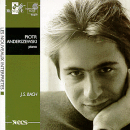Its some seven years since Piotr Anderszewski walked offstage during a performance of Webern's Variations, thereby forfeiting a place in the final of the Leeds International Piano Competition. Yet this was no artistic tantrum; rather a reaction to having just played the Diabelli Variations, and feeling he had nothing more to say at that point in time.
What strikes one about an Anderszewski recital is its quiet informality. The smart casual dress, the beaming smile: the audience might almost have collectively 'dropped round' to hear him rehearse for the recital, rather than be attending the event itself - though there's nothing provisional or unformed about his interpretations. Bach has been a lifelong preoccupation, and Anderszewski thinks nothing of programming two of the most substantial suites at either end of a recital. Not that his interpretational approach makes listening anything other than rewarding. In terms of keyboard technique, moreover, Anderszewski has the ideal combination of attributes for Bach: a superfine touch that varies dynamics from within the music, rather than applying them from without; natural voicing of the inner parts, though not to the point of fetish; a rhythmic sense that maintains buoyancy in the faster movements and prevents others from feeling weighed-down; and a sound that promotes textural clarity across the range of the concert grand.
Partita No. 6 crowns what is perhaps Bach's most varied keyboard cycle; and its succession of deftly-characterized dance movements, prefaced by a scintillating Toccata and rounded off by a spirited Gigue, was handled with conviction and a sense of inner enjoyment. English Suite No. 6 is the most substantial of what can often seem Bach's most forbidding collection. Anderszewski began the Prelude with touching intimacy, before tackling the toccata-like passage work with great rhythmic energy. The Sarabande and Double had a rapt inner calm, the contrast with the limpid quavers of the Gavottes and vaunting semiquaver triplets of the closing Gigue perfectly judged. Some occasionally provisional phrasing suggested Anderszewski was still weighing up possibilities during the performance; a spontaneity easy to underestimate in Bach interpretation.
Szymanowski is a relatively recent enthusiasm of Anderszewski's though, needless to add, his identification with the music's sensuous, though never narcissistic, sound world is total. The rarified ambience of the Op. 62 Mazurkas, the ailing composer's last completed work, belies the harmonic complexity and oblique rhythmic treatment of the dance archetype. The Third Sonata is his most realized larger statement: a fluid continuum, in which the four-movement model is refracted through a process of constant metamorphosis. Anderszewski went for maximun contrast over the 20 minute span, pushing coherence to its limit, while leaving no doubt that the defining and integrating of emotions was crucial to Szymanowski's thinking during the troubled aftermath of World War One. A powerful realization of a work still to enter the mainstream repertoire.
Recordings featuring Anderszewski have so far been few in number, though a superb disc of the Fifth French Suite and French Overture (Harmonia Mundi HMN911679) allows one to hear his very personal approach to Bach, in sound which does justice to his pianism. His recent signing to Virgin Classics promises much wider representation, including a Szymanowski disc, and the Diabelli Variations which first brought to notice this sensitive and thought-provoking musician.Richard Whitehouse

 Return to:
Return to: